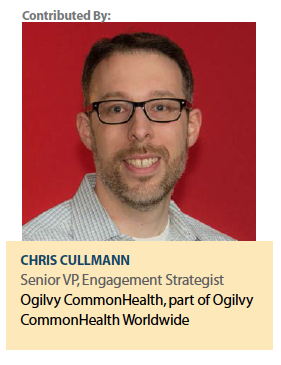 The ecosystem of social networks for healthcare professionals is incredibly diverse. For an increasing number of physicians in the United States, there is no epicenter for online dialogue like Facebook, nor a network with the meteoric growth of SnapChat or Instagram. What is happening is a quickly maturing and a highly specialized web of social networks, online groups, aggregators, and content providers that, when combined at varying percentages, serve special niche audiences.
The ecosystem of social networks for healthcare professionals is incredibly diverse. For an increasing number of physicians in the United States, there is no epicenter for online dialogue like Facebook, nor a network with the meteoric growth of SnapChat or Instagram. What is happening is a quickly maturing and a highly specialized web of social networks, online groups, aggregators, and content providers that, when combined at varying percentages, serve special niche audiences.
For savvy agencies and brands that plan to engage with physicians and healthcare professionals, this presents an opportunity to hone their marketing channel mixes and create programs specifically targeted for key audiences.
Targeting Audiences
There are many networks for healthcare professionals that offer large audiences, and even regular activity, that are exactly aligned with your needs. When you begin to develop programs, your first consideration should be: Is that audience using that specific channel the way you expect?
Physicians are using social networks to effectively have peer-to-peer sharing of articles, insights, and best practices beyond their immediate practice and physical area. Physicians now have solutions to share with other professionals in the same therapeutic area, practice type, and size. Physicians can also manage long-distance relationships between conferences and other professional gatherings. This can all be done in an infrastructure that offers compliance with patient privacy laws and the modern conveniences we are all familiar with on traditional social networks.
Professional networks also offer a level of curation that makes assessing the most important and relevant information less time-consuming. Many networks use algorithms and automation to manage what makes its way to a user’s field of view.
For many consumers, social media is synonymous with “real-time" updates. There are no differences for the healthcare professional. Whether Twitter or a specialized community for a practice area, the need for conference and media coverage, reactions to announcements, or participation in discussion around news: physicians are engaged and index high for their savvy media consumption. Last year Twitter recorded over 83,000 tweets in association with ASCO.1
Minding the Gap
Although it is easy to fall into a trap asking, “Why do we believe there are any differences in the way that healthcare professionals use social media for their work as opposed to anyone else?" it is important to remember that in the US, HIPAA and privacy issues remain a challenge for healthcare professionals. A study from the US National Library of Medicine2 shows that although 90% of surveyed physicians use social media for personal use, 65% are engaged in social media for “professional reasons." This survey also points to steady growth in both personal and professional adoption of social media in their physician responders. It is this gap that leaves a chance for professional communities and online groups to provide a venue for exchanges and peer-to-peer engagement.
Community Relations
The highly fragmented environment is what agencies and brand leadership need to be cognizant of to build relationships. Before engaging with a single physician, there needs to be a consideration: What do I have permission from this group or community to discuss? What do I have the authority to discuss? With the answers to both of these questions, you can have a meaningful relationship with any community.
The first:
“What do I have the permission to discuss?" is relating to boundaries. Whether this is a massive primary care community or a niche group, knowing the dialogue, tone, and role that you have is critical to knowing if you will be welcomed. Many brands, professional communication or otherwise, make the mistake of applying a foreign culture to an already active community, and become shunned. It is also critical to understand if you will be an outsider welcomed in as a guest or a bona fide member of the community.
The second:
“What subjects do I hold authority to lead and participate with?" This is a close second to permission, and very much related. For many drug manufacturers, brand leadership, or agencies, the response is simple: the product. Be sure that you are not introducing a powder keg topic or opinion that will polarize the community or have the members question your purpose in being present. It is also critical to tie your authority to your intended outcome (this last point is a linchpin concept for content strategists).
Consider the healthcare professional, specialist, or nurse that you are trying to reach — do you know where they are online, the sources they visit and trust? How can you augment their search for information and provide value to their day? Answering those questions and doing so aware of the tapestry of media and personalities they are going to come across can help find new and committed pundits for your brand. (PV)
Editor’s Notes:
1 http://the.oncology.agency/oncology-dominates-healthcare-conversation-on-twitter/
2 http://www.ncbi.nlm.nih.gov/pmc/articles/PMC4103576/
Ogilvy CommonHealth Worldwide — the health behavior specialists of Ogilvy &
Mather — is committed to creativity and effectiveness in healthcare communications, everywhere.
For more information, visit ogilvychww.com


















